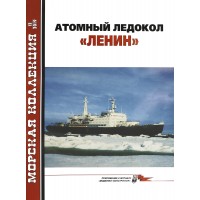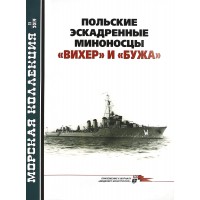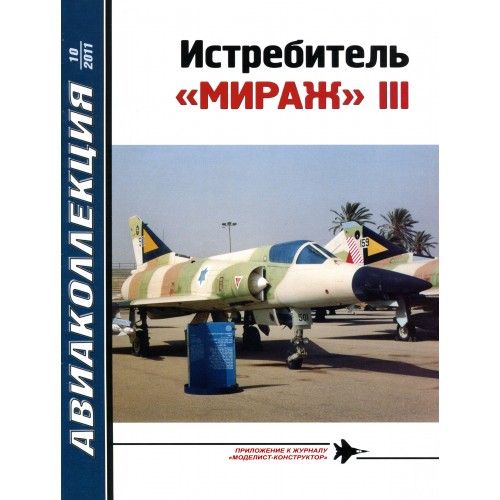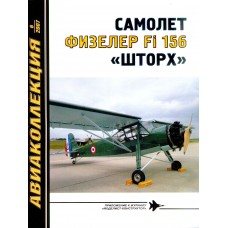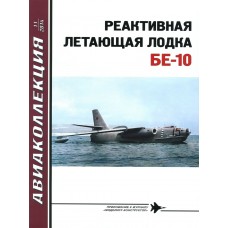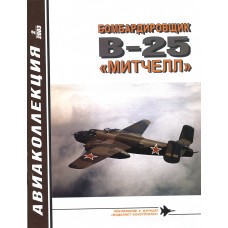AKL-201110 AviaCollection / AviaKollektsia series 10/2011: Dassault Aviation Mirage III French Supersonic Fighter-Interceptor Aircraft. Photos, schemes, colour pictures. 32 pages, soft cover, text in Russian.
CREATING OF AIRCRAFT
The history of the creation of this aircraft takes the count from the competition for the light (take-off weight of 5 - 6 tons) single supersonic (M = 1.3) interceptor, announced by the French Air Force command on February 4, 1953. The task was to aim the aircraft at the target from the ground and hit it with a missile launched from a fighter, as well as the ability to base the aircraft on unprepared (i.e. unpaved) sites. Seven projects were submitted to the competition: Dassault MO 550 Mister Delta, Breguet 1002, Sud-Est X-212 Durandal and X-212C Durandal II, Nord 500 Harpoon, Sud-West 80-9050 Trident II and Morane-Saulnier MS-1000. Only the projects of Dassault, Sud-Est and Sud-West companies reached the stage of “materialization”. Each of them was interesting in its own way.
The Mister-Delta project of Marcel Dassault’s company, which was developed on an initiative basis since 1952, was a tailless aircraft with two English Viper turbojet engines (which were licensed by this company) and a triangular keel . The group of designers that created it, led by A. Deplant and J. Cabriere, relied on the triangular wing, which was little known in its characteristics at that time, not promising enough for supersonic speeds.
The contract for the construction of two prototypes of the new MD 550 interceptor was signed on March 22, 1954, and work in Saint-Cloud, where the company was located, began to boil with even greater enthusiasm. Already on June 25, 1955, the first instance rose into the sky. Pilot R. Glavani tore the plane from the runway in Villaroche. During the 20-minute flight, the aircraft reached a height of 1000 m. The second flight was completed on the same day. The pilot generally responded positively to flight performance, while noting that there was insufficient ground stability in terms of flight intensity, engineers encountered significant difficulties, inevitable in creating a aircraft that was quite complicated for that time. From January to May 1956, the aircraft underwent major improvements. The triangular keel was replaced by swept. Power steering was built into the elevon control channel, and the wing span was reduced by 30 cm. The cockpit was equipped with a Martin-Baker ejection seat. Engines were equipped with afterburners that added 1000 kg of traction. In addition, an additional SERR 66 LPRE was installed with a thrust of 1,500 kg and an operating time of 80 s. The changes resulted in an increase in the mass of an empty aircraft to 3610 kg.
The tests of the modified sample began on May 5. Some progress was evident, but high speeds stubbornly did not want to submit to the new aircraft. Even with the afterburner turned on and the accelerator MD 550-01, already designated by that time the Mirage I, did not want to accelerate more than M = 1.6 at an altitude of 12,000 m. This was especially offensive, since the rival Sud-Est company "With her" Trident "came close to the border of the two Machs and negotiated the construction of six pre-production aircraft. She almost planned to make her brainchild the main interceptor of NATO.
In addition, the Air Force command revised its requirements, thoroughly changing approaches to creating an interceptor. Thus, the concept of director guidance from the ground was recognized as unrealistic due to the high cost and lack of appropriate equipment. At the same time, NATO's strategy began to change, and data appeared on the development of supersonic bombers. Now the military needed an interceptor that could operate autonomously, using its own radar for guidance. The requirements for maximum flight speed were increased, and the design team stubbornly moved to achieve two Machs.
However, it soon became clear that Mirage I was unlikely to produce a satisfying military aircraft, so all efforts were devoted to improving the second model, MD 550-02, which by that time had received the name Mirage II. The first aircraft was used as a flying laboratory in the development of¬
strategic bomber Mirage IV until May 1957, after which it was transferred to storage.
Although the second copy was designed for more powerful turbo engines "Gabizo" with a thrust on the afterburner of 1540 kg each, calculations showed that with them the desired speed could not be reached. The maximum that could be expected was M = 1.55 at an altitude of 12,000 m. Work on the second copy was stopped and switched to a more promising option - MD 550-03 Mirage III 001. Despite the external resemblance to from them. Firstly, the aircraft became larger and almost 30% heavier. The power plant - one Atar 101 <3.1 turbofan engine with a thrust of 4490 kg. At the request of the military, the booster rocket engine was retained, but the engineers immediately stipulated that it would be removable. The sweep of the wing along the leading edge was increased to 60 ° 34 'versus 55 ° in the first sample. In the rear part of the fuselage installed a container of the brake parachute.
When designing the fuselage, the novelty of those years was taken into account - the so-called "area rule", formulated in the early 1950s. talented aerodynamic R. Whitcomb. Its essence is that to reduce aerodynamic drag in the region of transonic speeds, the cross-sectional areas of the moving body along its length should be constant and tend to the area of the body of revolution. Simply put, the fuselage at the points of its articulation with the wing, stabilizer, engine nacelles and other protruding parts should be “pinched” as if to the cross sections “to the wing” and at the junction with the wing were approximately the same. To speed up the construction of the prototype, they decided to make the air intakes unregulated. The designers understood that this would affect speed, but in the conditions of extremely tight deadlines such a decision seemed reasonable.
Work on the Mirage III began at the end of 1955, and already on November 17 of the following year, R. Glavani first lifted a new aircraft into the sky. The flight lasted 40 minutes, speed limited to 700 km / h. Initially, there was no booster rocket engine on the plane; it was installed a month later. On December 17, pilot J. Muselli tested the rocket engine in flight.
Already on January 30, 1957, in the tenth flight, Glavani reached a speed corresponding to M = 1.52 at an altitude of 11,500 m, and then dived the aircraft to M = 1.6 in a dive with an angle of 20 °.
The fighter was finally believed. The Air Force command positively assessed its promise, and in April 1957 expressed its readiness to order an experimental batch of 10 pre-production Mirage IIIA aircraft. The contract was signed on May 9. On June 11, the inlet of the 62nd test flight was demonstrated at the 22nd Paris Air Show. The show made a strong impression on the government, and two weeks later the contract was approved.
In the meantime, the tests continued. On September 19, in the 78th flight, the troika with the accelerator turned on reached a speed corresponding to M = 1.8, and after a couple of weeks - M = 1.89. In practice, this was the limit of what could be "squeezed out" with unregulated air intakes.
As originally assumed, at the end of the first stage of testing, elongated air intakes with a moving central body in the form of a half-cone, nicknamed the “mouse”, were installed on the new Mirage. The central body moved along the guides back and forth and had three fixed positions. The pilot was controlling the semi-cones. Through the use of adjustable air intakes, thrust increased by 20%. In addition, the upgraded Atar 101G2 turbofan was installed on the aircraft.
AKL-201110 AviaKollektsia N10 2011: Dassault Aviation Mirage III French Supersonic Fighter-Interceptor Aircraft magazine
- Brand: AviaCollection / AviaKollektsia
- Product Code: AKL-201110 In Stock
-
$3.90
Available Options
Look at these products too:
AKL-200302 Aviakollektsia N2 2003: B-25 Mitchell WW2 Bomber magazine
AKL-200302 AviaCollection / AviaKollektsia series 2/2003: North American B-25 Mitchell WW2 Medium Bo..
$3.90



